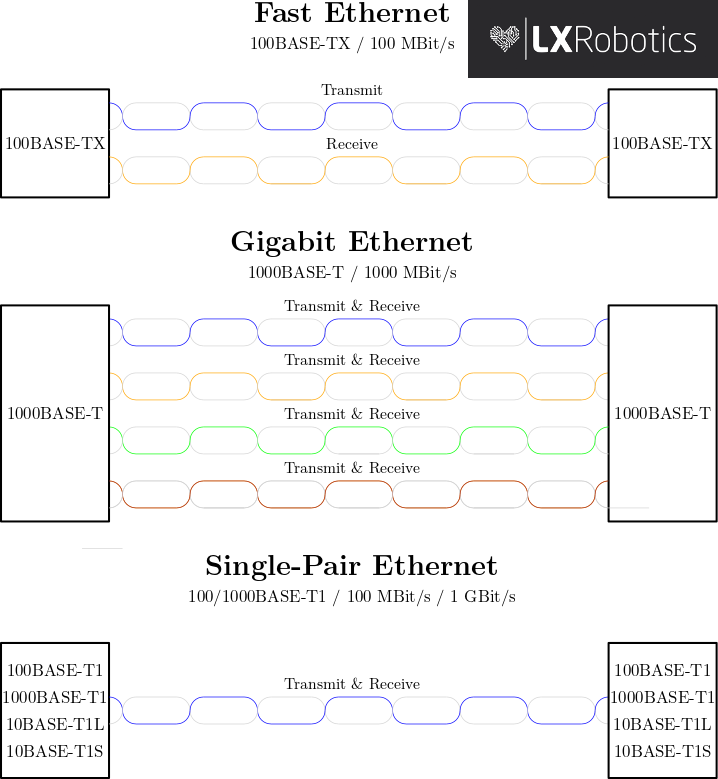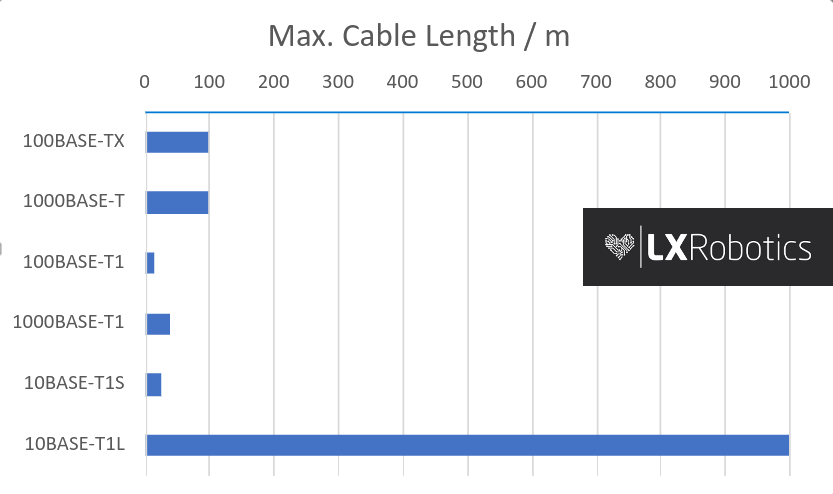What is Single-Pair Ethernet and why should you care?
Single-Pair Ethernet (SPE) emerges as a game-changing technology that facilitates data transfer over a single twisted pair of cables, distinguishing itself from traditional Ethernet configurations. SPE provides versatile applications with data rates ranging from 10 Mb/s to 1 Gb/s and maximum cable lengths ranging from 15 meters to 1 kilometer. Reduced cabling complexity, end-to-end IP-based communication, ease of adoption within existing Ethernet systems, extended transmission range, and multi-drop capability are among the advantages. The addition of Power over Data Line (PoDL) simplifies IoT integration. While there are still challenges, the future of SPE holds tremendous potential across industries, making it a technology worthy of attention and investment.
The Pika Spark is a micro robot control system containing 10BASE-T1S, 1000BASE-T, CAN/CAN FD and RS485 interfaces developed by LXRobotics.
What is Single-Pair Ethernet?
- Single-Pair Ethernet is an Ethernet technology variant that transfers data over a single twisted pair of cables. This is different from standard Ethernet cables, which use two or four pairs of wires.
- Single-Pair Ethernet data rates range from 10 Mb/s (10BASE-T1S/T1L) to 1 Gb/s (1000BASE-T1).
- Maximum supported cable length range from 15 meters up to 1 kilometer (10BASE-T1L).
- While the default network topology is a star topology as in standard Ethernet there’s a specification for a real-time capable Ethernet using a single shared bus (10BASE-T1S).
What are relevant IEEE standards concerning Single-Pair Ethernet?
Single-Pair Ethernet is specified in various amendments to IEEE 802.3:
| IEEE 802.3 | Name | Bandwidth | Range | Topology | Application |
|---|---|---|---|---|---|
| 802.3bw-2015 | 100BASE-T1 | 100 Mbit/s | 15 m | Point-to-Point | Robotics/Autonomous Driving |
| 802.3bp-2016 | 1000BASE-T1 | 1000 Mbit/s | 15 - 40 m | Point-to-Point | Robotics/Autonomous Driving |
| 802.3cg-2019 | 10BASE-T1L | 10 Mbit/s | 1000 m | Point-to-Point/PoDL | Long-Range Sensors/Actuators |
| 802.3cg-2019 | 10BASE-T1S | 10 Mbit/s | 15 - 25 m | Multi-Drop | CAN Bus Replacement |
| 802.3bu-2016 | Power-over-Data-Line (PoDL) | - | - | - | 0.5 to 50 W |
What are benefits of Single-Pair Ethernet?
Reduced Complexity of Cabling Infrastructure
The primary benefit of Single-Pair Ethernet is reduced infrastructure complexity. Traditional Ethernet cables, such as Cat5e or Cat6, are made up of 4 twisted pairs of wires (1000BASE-T or “Gigabit-Ethernet”). Not every networked device (for example, Industrial IoT applications) requires the full data transmission rate made possible by utilizing all of these pairs, which adds unnecessary complexity and cost. Single-Pair Ethernet uses only a single twisted pair of cables, greatly simplifying cabling infrastructure, lowering costs, and allowing for much smaller connectors.

End-to-End IP based Communication
Single-Pair Ethernet is able to provide seamless end-to-end IP based communication. This means that devices such as sensors, actuators, and other Internet of Things (IoT) devices can be directly connected to the IP network, eliminating the need for separate gateways or intermediary devices. Furthermore, the software stack can be greatly simplified because there is no longer any need to account for the unique characteristics of various field buses and replace it with an all IP-based communication stack. One example would be Cyphal, an open technology for real-time intravehicular distributed computing and communication which can be run on top of Single-Pair Ethernet.

Ease of Adoption
Because Single-Pair Ethernet operates within the familiar ecosystem of Ethernet, it’s easier for organizations to adopt. Network administrators and IT professionals are typically well-versed in Ethernet, and their prior knowledge and skills can be directly applied to SPE.
Full Duplex
Single-Pair Ethernet is full-duplex (except 10BASE-T1S) meaning that it can simultaneously transmit and receive. In comparison 100BASE-TX requires two pairs of cables (one for transmit, one for receive) while achieving only the same data rate as 100BASE-T1.
10BASE-T1L: Increased Range (up to 1 km)
Single-Pair Ethernet is ideal for applications that require connectivity over large areas because it can transmit data up to 1 kilometer. This feature is especially useful in industrial settings, building automation, and smart cities.

10BASE-T1S: Multi-Drop Capable (shared bus topology)
The 10BASE-T1S variant of Single-Pair Ethernet use multi-drop to allow multiple devices to connect to the same cable on a single shared bus topology. This is the same network topology used by Controller Area Network (CAN), and it differs from the standard Ethernet bus topology, which is a star topology. This efficient configuration eliminates the need for separate cables for each device as well as the central switch, making it ideal for use cases in which multiple sensors and actuators are daisy-chained with one another.

The L3X-Z hexapod robot uses both CAN and 10BASE-T1S for interconnecting its various sensors and actuators.
Power over Data Line (PoDL): data lines double as power supply
This feature allows for the use of the same pair of wires for data communication and power supply, eliminating the need for separate power cabling. This has the potential to transform IoT applications by allowing devices to be powered and connected with a single cable.
Note: PoDL is not specified for all Single-Pair Ethernet PHYs: 10BASE-T1S currently has no specification for PoDL.
What will be the future of Single-Pair Ethernet?
The potential applications of Single-Pair Ethernet are numerous and varied as the wave of digital transformation sweeps across various sectors. From Industry 4.0 to connected homes and self-driving cars, Single-Pair Ethernet has the potential to be a significant enabler of technological progress. However, some obstacles must be overcome before Single-Pair Ethernet can be widely adopted. One of the most important is the creation of a robust ecosystem of Single-Pair Ethernet compatible devices and equipment. Furthermore, raising awareness and educating people about Single-Pair Ethernet is critical for its widespread adoption.
Finally, Single-Pair Ethernet is a networking technology with enormous potential in the age of IoT and smart infrastructure. Its ease of use, extended reach, compact design, and PoDL support make it an appealing solution for a wide range of applications. Understanding and leveraging Single-Pair Ethernet will become increasingly important as the world becomes more interconnected. In my opinion it is not a question of if – but when – Single-Pair Ethernet will become an essential component of our interconnected future. As a result, whether you’re a business professional, a tech enthusiast, or a regular consumer, Single-Pair Ethernet deserves your attention.

Alexander Entinger is a highly experienced embedded engineer with a focus on robotic systems. One of the key components of his consulting practice is providing both expert knowledge and hands-on delivery on the subject of Single-Pair Ethernet and its integration into robotic systems.

